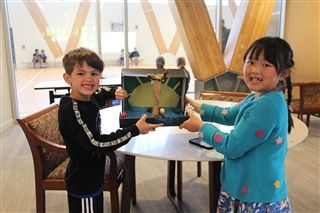To showcase the knowledge they had learned during their recent IB PYP Unit of Inquiry on ‘Sharing the Planet,’ the Grade 1 classes chose an animal and then created habitat dioramas to illustrate the central idea that “living things have features and behaviours that help them survive.”
In pairs, students did research, finding out what predators there were for their animal, what they ate, and what were the components of their habitat. After their research, students built habitats out of recycled and natural materials they collected outside. Their habitat could only include things they felt their animal needed to survive.
It took the students about three periods to complete their dioramas, and it was the first time the Grade 1s had the chance to work in the Innovation Lab. Using the design cycle, they first had to draw out what they wanted to create and then developed a plan. That included labelling all the materials they wanted to use.
The students chose a variety of animals to research for this project including orcas, beavers, bald eagles, salmon, honey bees, dragonflies and spiders.
Ophira and Arnaz were partners and they created a habitat for the barred owl.
“We tried to add a lot of detail, like eggs in the nest, a barred owl in the tree and we have a bit of a forest ground,” explained Ophira.
To find out what type of features their habitat should include, Ophira and Arnaz did research using their iPads and books.
“We learned what they ate, where they live, their wingspan (40 to 63 metres),” they said.
“My favourite thing that we learned about the barred owl is that their ears are holes, they don’t stick out,” added Arnaz.
Lillian and Avery partnered together to create a habitat for a bald eagle.
“We made a nest out of pipe cleaners and moss,” explained Lillian.
To design the habitat, the pair researched what bald eagles ate, their habitat, behaviours and features, predators and interesting facts.
“One of the bald eagle’s features is that the brown feathers on their body and the white feathers on their head makes the bald eagle easy to see,” they explained. “Also, a bald eagle can fly for more than an hour, and they can live up to 28 years in the wild.”
Way to go Grade 1s for being innovative and resourceful in making all of these special habitats!





